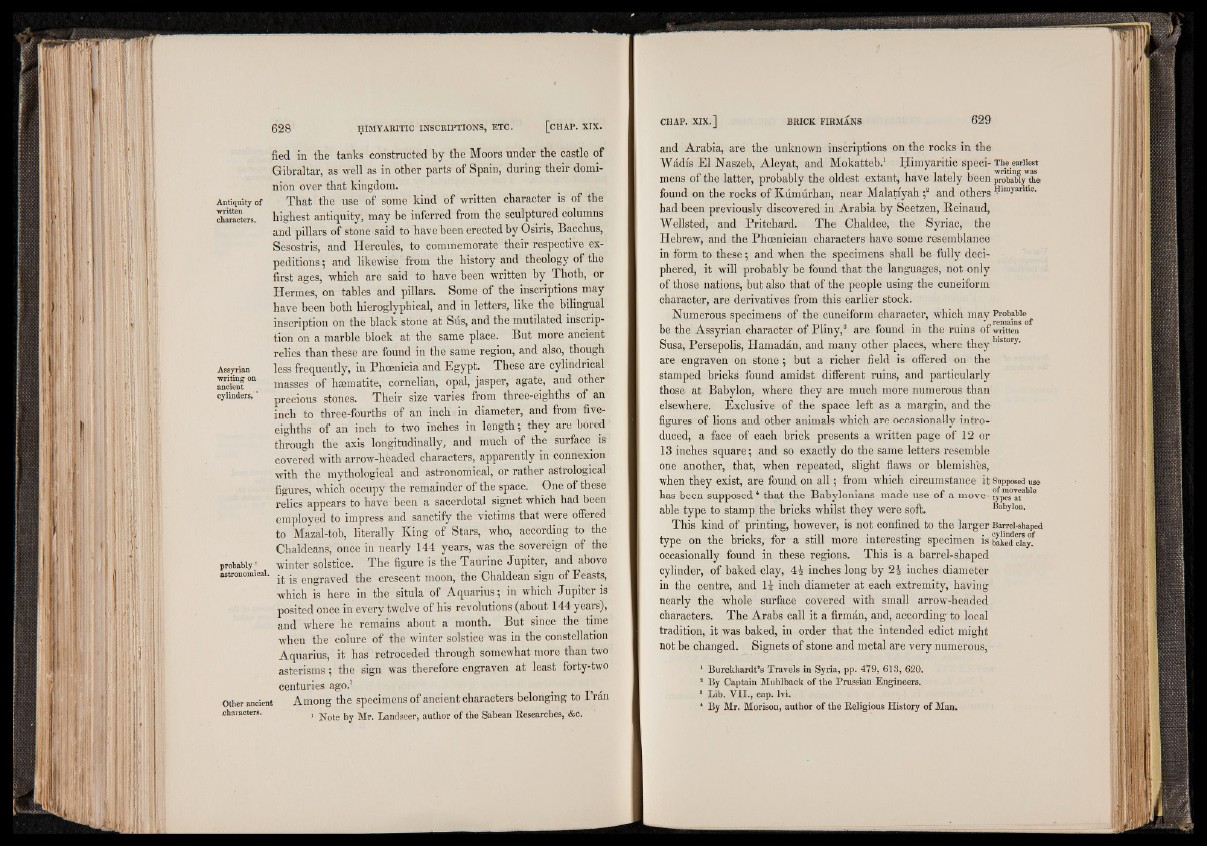
Antiquity of
written
characters.
Assyrian
writing on
ancient
cylinders,'
probably I
astronomical.
fied in the tanks constructed by the Moors under the castle of
Gibraltar, as well as in other parts of Spain, during their dominion
over that kingdom.
That the use of some kind of written character is of the
highest antiquity, may be inferred from the sculptured columns
and pillars of stone said to have been erected by Osiris, Bacchus,
Sesostris, and Hercules, to commemorate their respective expeditions
Other ancient
•characters.
; and likewise from the history and theology of the
first ages, which are said to have been written by Thoth, or
Hermes, on tables and pillars. Some of the inscriptions may
have been both hieroglyphical, and in letters, like the bilingual
inscription on the black stone at Sus, and the mutilated inscription
on a marble block at the same place. But more ancient
relics than these are found in the same region, and also, though
less frequently, in Phoenicia and Egypt. These are cylindrical
masses of haematite, cornelian, opal, jasper, agate, and other
precious stones. Their size varies from three-eighths of an
inch to three-fourths of an inch in diameter, and from five-
eighths of an inch to two inches in length; they are bored
through the axis longitudinally, and much of the surface^ is
covered with arrow-headed characters, apparently in connexion
with the mythological and astronomical, or rather astrological
figures, which occupy the remainder of the space. One of these
relics appears to have been a sacerdotal signet which had been
employed to impress and sanctify the victims that were offered
to Mazal-tob, literally King of Stars, who, according to the
Chaldeans, once in nearly 144 years, was the sovereign of the
winter solstice. The figure is the Taurine Jupiter, and above
it is engraved the crescent moon, the Chaldean sign of Feasts,
which is here in the situla of Aquarius; in which Jupiter is
posited once in every twelve of his revolutions (about 144 years),
and where he remains about a month. But since the time
when the colure of the winter solstice was in the constellation
Aquarius, it has retroceded through somewhat more than two
asterisms; the sign was therefore engraven at least forty-two
centuries ago.1
Among the specimens of ancient characters belonging to I ’ran
1 Note by Mr. Landseer, author of the Sabean Researches, &c.
and Arabia, are the unknown inscriptions on the rocks in the
Wadis El Naszeb, Aleyat, and Mokatteb.1 Himyaritic speci- The earliest
mens of the latter, probably the oldest extant, have lately been probaWyW*e
found on the rocks of Kumurhan, near Malatiyah f and others
had been previously discovered in Arabia by Seetzen, Reinaud,
Wellsted, and Pritchard. The Chaldee, the Syriac, the
Hebrew, and the Phoenician characters have some resemblance
in form to these; and when the specimens shall be fully deciphered,
it will probably be found that the languages, not only
of those nations, but also that of the people using the cuneiform
character, are derivatives from this earlier stock.
Numerous specimens of the cuneiform character, which may Probable^
be the Assyrian character of Pliny,3 are found in the ruins of written
Susa, Persepolis, Hamadan, and many other places, where they story'
are engraven on stone; but a richer field is offered on the
stamped bricks found amidst different ruins, and particularly
those at Babylon, where they are much more numerous than
elsewhere. Exclusive of the space left as a margin, and the
figures of lions and other animals which are occasionally introduced,
a face of each brick presents a written page of 12 or
13 inches square; and so exactly do the same letters resemble
one another, that, when repeated, slight flaws or blemishes,
when they exist, are found on a ll; from which circumstance it Supposed use
has been supposed4 that the Babylonians made use of a move- ty^s atab 8
able type to stamp the bricks whilst they were soft. Babylon.
This kind of printing, however, is not confined to the larger Barrel-shaped
type on the bricks, for a still more interesting specimen is baked ciayf
occasionally found in these regions. This is a barrel-shaped
cylinder, of baked clay, 4 i inches long by 2 i inches diameter
in the centre, and 1J inch diameter at each extremity, having
nearly the whole surface covered with small arrow-headed
characters. The Arabs call it a firman, and, according to local
tradition, it was baked, in order that the intended edict might
not be changed. Signets of stone and metal are very numerous,
1 Burckhardt’s Travels in Syria, pp. 479, 613, 620.
1 By Captain Muhlback o f the Prussian Engineers.
* Lib. Y II., cap. lvi.
| By Mr. Morison, author o f the Religious History of Man.